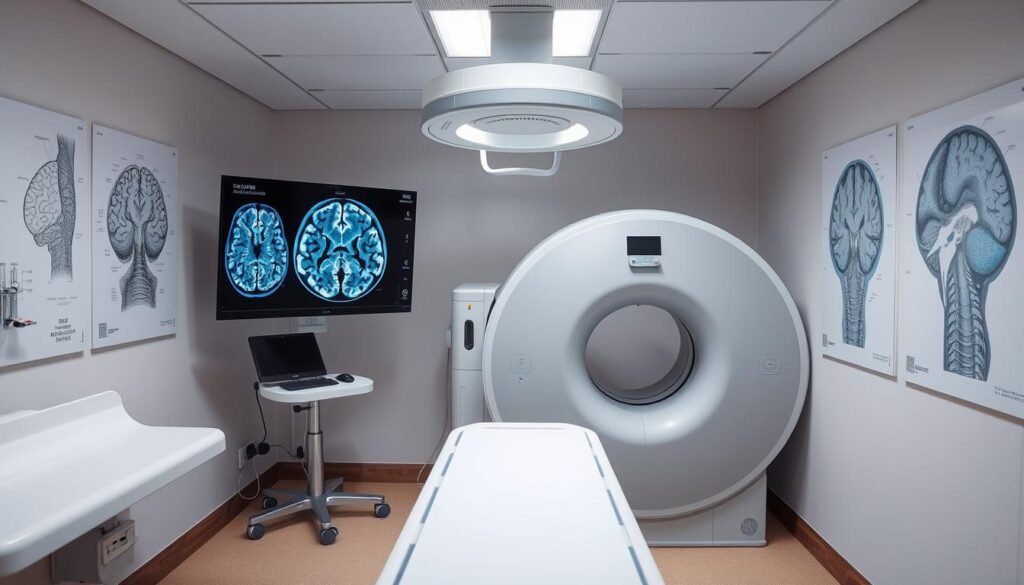About half of the people with lung cancer will face brain metastases. This fact highlights how critical it is to know the symptoms of cancer spreading to the brain. When lung cancer cells move to the brain, they can worsen the patient’s health and life quality.
It’s key to spot symptoms of lung cancer spreading to the brain early. Early detection can lead to treatments that might help a lot. Knowing what to look for helps patients and their families act fast to get medical help. This article will explore the main signs of lung cancer’s dangerous move to the brain, aiming to boost understanding and alertness about this grave issue.
Key Takeaways
- Approximately 50% of lung cancer patients may develop brain metastases.
- 25% of lung cancer patients already exhibit brain metastases at diagnosis.
- Average survival for individuals with brain metastases from lung cancer is often less than six months.
- Specific genetic mutations in certain lung cancers increase the risk of brain spread.
- Recognizing symptoms early can significantly improve treatment options.
Understanding Brain Metastases
Brain metastases happen when cancer from another body part spreads to the brain. This is common in lung cancer patients. About 15-20% of adults with non-small cell lung cancer (NSCLC) have brain metastases at diagnosis. Eventually, up to 40% might develop this complication.
Brain metastases can appear as one or more tumors, showing different neurological symptoms. People often face challenges with brain function and well-being. The survival rate for those with lung cancer spread to the brain is roughly 12 months. However, new treatments are improving these outcomes. Recognizing the impact of brain metastases on daily life is crucial for patients and caregivers.
Treatments for brain metastases focus on relieving symptoms and improving life quality. Immunotherapy, especially combined with radiation, helps improve survival rates compared to radiation alone. Understanding brain metastases is critical for navigating this complex condition.
The survival rate for advanced non-small cell lung cancer is about 8.2%. For advanced small cell lung cancer, it drops to 3.6%. The high occurrence of brain metastases underscores the importance of early medical evaluation. For more on this topic, visit detailed information about how lung cancer metastasizes to the brain.
How Lung Cancer Spreads to the Brain
Lung cancer can spread when cells from the main tumor break away. They can travel to the brain and other body parts. Often, they move through the blood or lymph systems. Around half of the people with lung cancer will have it spread to their brain during their disease. At the time they find out they have lung cancer, 25% will already have brain metastases.
There are two primary lung cancers: small-cell (SCLC) and non-small-cell (NSCLC). SCLC is more likely to spread to the brain because it’s very aggressive. Research shows that 50% to 60% of patients with certain gene mutations in their lung cancer will see it spread to their brain.
Once in the brain, lung cancer cells can grow fast. They make new blood vessels to get what they need to grow. Things like smoking can affect this growth. Brain metastases can cause different symptoms, like headaches or confusion. People might see changes in their vision or have trouble speaking or moving properly.
To illustrate the frequency and impact of lung cancer metastasis, consider the following table:
| Statistic | Percentage |
|---|---|
| Patients developing brain metastases | 50% |
| Patients with existing metastases at diagnosis | 25% |
| EGFR or ALK-positive patients developing brain metastases | 50% – 60% |
| Average survival post-diagnosis of brain metastases | Less than 6 months |
Lung Cancer Spread to Brain Symptoms
Lung cancer can result in the cancer moving to the brain. This leads to various symptoms. It’s important to know these lung cancer spread to brain symptoms for early treatment. Neuropsychiatric symptoms are common and can look like other conditions. Spotting these signs early can help a lot.
Common Symptoms of Brain Metastases
People with lung cancer and brain metastases might feel:
- Headaches
- Vision problems
- Changes in memory and cognition
- Difficulty speaking
- Loss of balance
- Seizures
These symptoms point to serious brain issues from lung cancer. They need fast checking by a doctor. Early checks can spot brain involvement in lung cancer.
Focal vs. Global Symptoms
Brain metastases cause two kinds of symptoms. Focal symptoms happen because of tumors in certain brain parts. For example:
- Weakness on one side of the body (focal symptom affecting motor control)
- Vision changes (focal symptom affecting the occipital lobe)
Global symptoms affect the whole brain. They might include:
- Confusion and memory problems
- Personality changes
- Difficulty concentrating
Both types affect life quality and show how far the disease has gone.
Risk Factors for Developing Symptoms
Several factors increase the chance of these symptoms. Some genetic mutations make brain metastases more likely. Generally, 50% of those with lung cancer will get brain metastases. Knowing these risks is key for early action.
Signs of Lung Cancer in the Brain
Knowing the signs of lung cancer in the brain is key for early help. People with secondary brain tumors often have clear symptoms. These include lasting headaches and changes in how they think. Spotting these signs early means getting help faster, which can greatly improve treatment success.
Pain and Headaches
Many with lung cancer in the brain talk about pain and headaches. These headaches get worse in the morning and can change in how bad they are. If headaches keep getting worse and are very bad, it could mean there are tumors in the brain from lung cancer. Seeing a doctor for these symptoms is very important for finding out what to do next.
Changes in Memory and Cognition
Changes in how we think is another big sign lung cancer has spread to the brain. People might find it hard to remember things or concentrate. They could also get mixed up over simple tasks. These changes can really impact someone’s everyday life and their relationships. Noticing these changes early leads to getting help sooner, which focuses on keeping life as good as possible.

| Symptom | Description |
|---|---|
| Headaches | Severe headaches that worsen in the morning. |
| Memory Issues | Difficulty recalling information or remembering recent events. |
| Cognitive Decline | Challenges with problem-solving and decision-making. |
Identifying Neurological Symptoms from Lung Cancer
It’s important to recognize neurological symptoms from lung cancer, especially during brain metastasis. Patients might notice several issues that affect daily life. These can include slurred speech, trouble seeing, and coordination problems.
About 73.8% of people with brain metastases from non-small cell lung cancer report neurological symptoms. They might show focal deficits, signs of high intracranial pressure, or even have seizures. Spotting these signs early can lead to a better outlook for patients.
Those without symptoms of brain metastases tend to live longer, around 11 months versus 7 months. Spotting neurological symptoms from lung cancer early is crucial. It may lead to better treatment results.
Below is a summary of neurological symptoms:
| Type of Symptom | Percentage of Patients |
|---|---|
| Focal Deficits (e.g., ataxia, paresis) | 61.3% |
| Signs of Increased Intracranial Pressure | 30.0% |
| Epileptic Seizures | 13.9% |
| Neuropsychological Symptoms (e.g., memory loss) | 14.5% |
Being aware of neurological symptoms is critical. For lung cancer patients, knowing about brain metastasis is vital. Early detection leads to better treatment and support. Learn more from a detailed study on small cell lung cancer brain impact.
Diagnostic Procedures for Brain Metastasis
Knowing if there’s brain metastasis is key for planning treatment. To check for tumors in the brain, doctors use various methods. They look at the brain’s condition through neurological exams and imaging tests.
Neurological Exam Techniques
Neurological exams check different brain functions like:
- Reflexes
- Muscle strength
- Coordination
- Sensory response
These tests show how metastatic tumors affect the brain. Doctors also ask about symptoms to understand the disease better.
Imaging Tests for Accurate Diagnosis
Imaging tests are vital for seeing the tumors. MRI is often used to find and measure them in the brain. Sometimes, doctors use a special dye to get clearer MRI images.
Other key tests include CT scans and PET scans. They give more details and help confirm the diagnosis. Here is a table with the main imaging tests for brain metastases:
| Imaging Test | Description | Primary Use |
|---|---|---|
| MRI | Utilizes strong magnets and radio waves | Locating and sizing brain tumors |
| CT Scan | Combines X-ray images for a detailed view | Assessing brain structure and identifying abnormalities |
| PET Scan | Involves the injection of a radioactive tracer | Evaluating metabolic activity of tumor cells |
These techniques are crucial for creating effective treatment plans for brain metastasis. Early diagnosis plays a big part in helping patients live longer. For more about lung cancer spreading to the brain, visit this resource.

Treatment Options for Lung Cancer Brain Metastasis
Lung cancer spreading to the brain is treated with different strategies. These methods aim at tackling the cancer and its brain symptoms. Using personalized care like *targeted therapies for cancer* boosts success, especially with treatments matched to a person’s genes.
Medications and Targeted Therapies
Medication is key in treating lung cancer brain metastasis. Targeted therapies are now more common for those with certain genetic changes. Drugs like osimertinib for EGFR mutations and alectinib for ALK mutations are effective against brain cancer spread. Such treatments, known as tyrosine kinase inhibitors (TKIs), have greatly improved patient results.
Radiation Treatments
Radiation therapy is highly beneficial for brain metastasis patients. Stereotactic radiosurgery (SRS) is a preferred method over the older whole-brain radiation therapy (WBRT). SRS offers good survival rates and better mental function, especially for smaller tumors without symptoms. Often, SRS is combined with targeted treatments to better manage the cancer.
Potential Role of Surgery
In certain lung cancer brain metastasis cases, surgery is crucial. It might be needed for large or bothersome tumors. Adding surgery to radiation therapy improves life expectancy for those with a single brain metastasis. A teamwork approach tailors treatments to each person, improving their health outcome.
| Treatment Method | Patient Type | Expected Outcomes |
|---|---|---|
| Targeted Therapies | EGFR/ALK mutations | Improved control of brain metastases |
| Stereotactic Radiosurgery | Small, asymptomatic lesions | Comparable survival with better cognitive outcomes |
| Surgical Resection | Large or symptomatic tumors | Enhanced survival when combined with radiation |
Prognosis and Survival Rates for Brain Metastases
The outlook for people with brain metastases from lung cancer is complicated. Survival rates for lung cancer depend on many factors. These include the patient’s age, health, and the cancer’s characteristics. Knowing these can help predict outcomes and plan treatments.
Factors Influencing Survival
Several factors impact survival rates for lung cancer patients with brain metastases. These are:
- Age: Younger patients usually have better chances than those over 65.
- Gender: Women might have factors that improve their survival rates.
- Race and Marital Status: Being married and white can lead to a better outcome.
- Stage of Cancer: Higher stages mean lower survival chances.
The average survival time for lung cancer patients with brain metastases is about 12.2 months. But, individual situations can cause big differences in this time.
Recent Advances in Treatment Outcomes
New treatments and better radiation methods are helping patients live longer. For example, using whole-brain radiation with corticosteroids has shown some positive effects. While untreated brain metastases may only allow 1 to 3 months of survival, treated patients can live much longer.
Supportive Care for Patients with Brain Mets
Supportive care improves life quality for those with brain metastases from lung cancer. It offers services to help patients manage symptoms and face their condition’s challenges. Palliative care lung cancer focuses on the patient’s well-being, not just the disease.
Importance of Palliative Care
Palliative care provides in-depth support for lung cancer patients whose cancer has spread to the brain. It eases symptoms like pain, nausea, and cognitive issues, focusing on patient comfort and dignity. Optimal supportive care lung cancer leads to longer, better lives than just local treatments.
Treatments include corticosteroids, painkillers, and targeted therapies. These are part of the care model, managing symptoms and lessening brain metastases’ effects.
Rehabilitation Resources
Rehabilitation resources help patients regain function and independence. Services like physical therapy improve strength and mobility. Occupational therapy helps with daily activities, and speech therapy aids those with communication challenges.
Access to specialized rehabilitation services boosts a patient’s recovery, especially for those with neurological symptoms. Tailored rehabilitation plans are crucial for many, making it a key part of supportive care lung cancer.
Recognizing Emergency Signs
Knowing when to get medical help is crucial for those with lung cancer. This is especially true when brain metastases may be developing. Spotting emergency signs of lung cancer quickly can help start treatment sooner. This can greatly improve the outlook and survival of the patient.
When to Seek Immediate Medical Attention
Being aware of certain symptoms is important. They tell patients and families when to get help. Key signs to watch for include:
- Sudden severe headaches that feel different from normal ones
- Seizures, especially if the patient never had one before
- Significant changes in consciousness, like confusion or sleepiness
- Visual disturbances such as blurry vision or losing sight
- Weakness or numbness in the arms or legs that starts suddenly
About half of people with lung cancer will get brain metastases. That’s why it’s vital to watch for these signs. If these symptoms appear, they should be taken as red flags. Immediate medical advice should be sought.
Getting help right away when noticing these signs is critical. It can lead to an earlier diagnosis and treatment. This is key to achieving the best results. For more on lung cancer, check out this detailed guide.

The Psychological Impact of Lung Cancer Brain Mets
Lung cancer brain metastases bring big challenges for patients and families. The psychological impact cancer has can be deep, leading to more anxiety, depression, and stress. It’s key for everyone involved to understand these effects as they go through their treatment journey.
Coping Mechanisms for Patients and Families
It’s important to find ways to cope with the impact of lung cancer. Emotional support, good communication, and planning can help. Coping strategies that work well include:
- Engaging in open discussions about feelings and concerns with family and friends.
- Seeking professional counseling or therapy to address emotional challenges.
- Participating in support groups that connect patients and families facing similar struggles.
- Staying informed about treatment options, such as those outlined in detailed resources regarding radiation treatments for lung cancer.
- Maintaining a balanced diet and exercise routine to enhance physical health and emotional resilience.
Cognitive issues, often called cancer-related cognitive impairments (CRCI), need special strategies. These challenges can impact work and daily life, highlighting the need for support.
Noticing the signs of coping with lung cancer needs a space where feelings and worries can be shared. Both patients and their families should focus on mental and physical health. This approach is key for a well-rounded recovery.
| Coping Mechanisms | Description |
|---|---|
| Open Communication | Encouraging discussions about treatment and emotions within the family. |
| Professional Support | Using therapists or counselors specialized in cancer care. |
| Support Groups | Joining groups with shared experiences for emotional support. |
| Physical Activity | Doing exercises to improve mood and health. |
| Nutritional Management | Eating well to boost overall well-being. |
Conclusion
The lung cancer brain metastasis overview shows how crucial early detection is. Spotting symptoms of brain metastases early on is key since about half of the people with lung cancer will face these brain challenges. This can deeply affect their life and survival. Brain metastases awareness is important, as doctors and families play a big role in tackling this issue.
There are new treatments on the horizon, like targeted therapies and immunotherapy. These treatments bring hope for handling lung cancer that spreads to the brain. It’s vital for patients and their families to keep up with these breakthroughs. They could lead to better results and longer lives.
It’s important to talk to doctors early if facing a lung cancer brain metastasis. Knowing about the treatment choices can give patients control. Raising awareness and having open talks about symptoms and treatments is key. It helps in dealing with the challenges of this diagnosis.